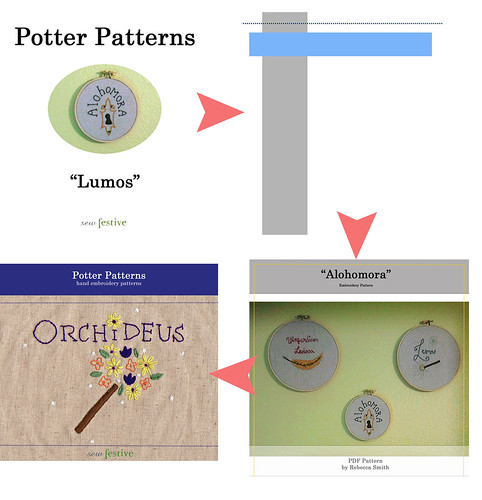Today I thought I'd move right past the sewing [yes, yes, feel free to leave now if you'd like. but come back on Friday for some good old-fashioned quilting updates!] and into the more technical aspect of this hobby.
Who would like to take some of their original ideas/designs and produce patterns for them?
::raises hand::
Who wants to make sure those hypothetical patterns look professional?
::raises both hands, and the hands of the person next to her::
I'd imagine that most of us would like our work to be well-received, not just on the sewing side, but also on the way we brand or package those ideas. That's generally why most people start to edit the layout of their blog after they've started to master the actual, um, blogging part.
So what's a person to do when they aren't a graphic designer/professional photographer/billionaire?
Here are some of the things that I've learned on the designing-a-pattern side of things over the past month or so as I've been developing my Harry Potter embroidery patterns:
1. Be prepared to put in WAY more work than you ever thought it would take.
2. Window-shop the Internet. That is to say, what is it about the patterns that you buy that appeals to you? If you're me, you've never purchased a pattern [except clothing patterns], so go out and buy one. I now have a super cute snowflake embroidery pattern that I'm excited to stitch later.
 |
| Image from Shutterfly |
I also really like to look at card and stationary websites because they have great ideas to help with placement of images across an area of space.
 |
| Image from Fat Quarter Shop |
3. Pinpoint your style. Yes, you want to appeal to other people, but it's harder to produce an appealing product if YOU don't even like the way it looks. I personally like modern, simple, stream-lined graphics.
| Chelsea turned me on to PuglyPixel. Go. Learn about Photoshop. Now. |
4. Read. A lot. When I was trying to determine how I wanted the front page of my patterns to look I devoured as much information as I could. Some nights I got the worst headache from trying to understand the technical aspect, from trying to feel like my brain wasn't overloaded on information.
5. If you're serious, invest in some good software, like Photoshop. Even if you don't have the latest and greatest version [ahem...me...].
Now, even my testers got some of the early stages of the pattern's cover; they just got an early version with pictures of the original hoops from a year ago, but I thought I'd show where the cover page morphed from:
And oh, and there's a full peek at one of the patterns...whoops ;)


This is good to know. I just drew somethin' and if it works out I'd love to progress it into a pattern. I love your embroideries!
ReplyDeleteThanks for sharing this, Rebecca. I've been mulling over whether to design some patterns and the graphics part is one of my weaknesses.
ReplyDeleteThanks for the post. It's interesting to see the work that goes into making a pattern. I'll book mark this for later as I have a few ideas.
ReplyDeleteThanks for the pattern sneaks. =D